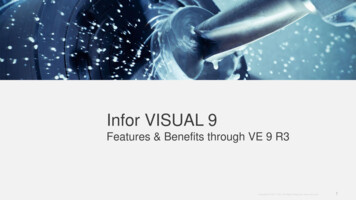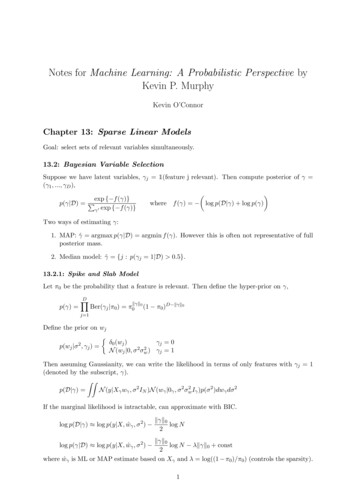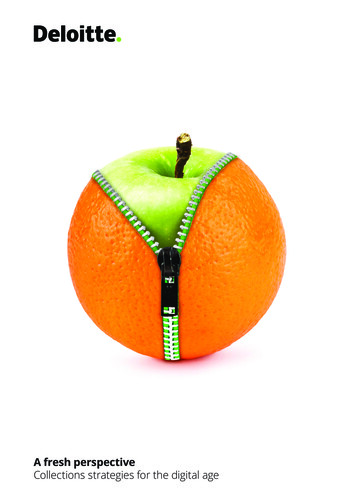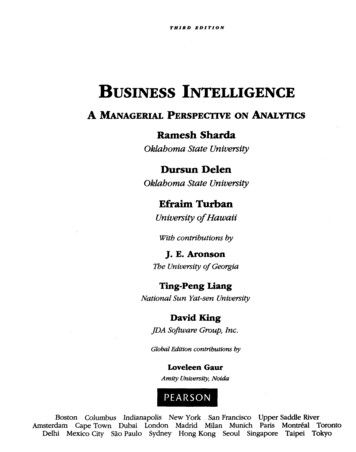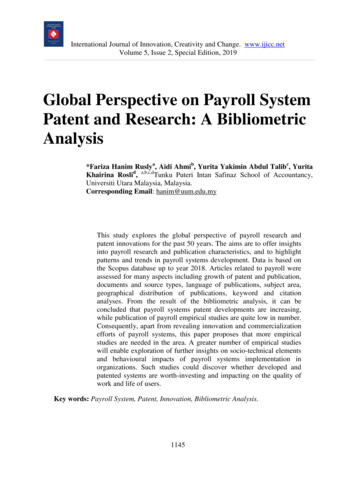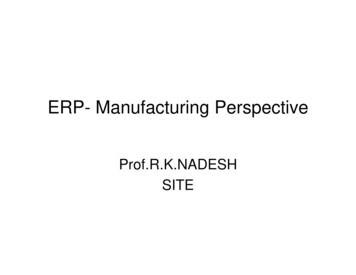
Transcription
ERP- Manufacturing PerspectiveProf.R.K.NADESHSITE
Introduction -Manufacturing 30% Growth –Automobile,Steel(TISCO),Pharmaceuticals(WHO) Spends on IT to look after the scale of their operations- Controlling Inventory- Production Cost- Marketing Cost- Better Decision Making
Major Investment Heads InfrastructureS/w Design & Application DevelopmentS/w PackagesERP PackagesConsulting ServicesExternal Connectivity (Dealer / Supplier)Data WarehousingE-Commerce
ERP High impact area (leads to bottom-upchange in an organization) Integration of finance with logistics Distribution of Products Selecting of ERP Solutions (SAP,BAANERP)
CAD/CAM Major Focused area –IndustriesAutomotive & Aerospace IndustriesM&M – Doubled the capacity (Tractor Division)Enhancement in Design CapacityTATA Johnson – Seats – Ford & OthersFollowedMajor Focused Area1. Design Analysis2.Development3.Manufacturing
MRP
Distribution Requirements Planning Extension of MRP into physical distributionsystem ( Distribution Inventory) By improving the linkage between marketplace requirements and manufacturingactivities Future requirements – Supply of productsto the demand for them.
JIT & Kanban JIT is a production philosophy & not antechnology(Goods & Service- When Needed) JIT uses PULL method of SchedulingMaterial Flow(Kanban) Aim – to make goods available JUST INTIME
JIT Principles* Elimation of Waste1. Removal of any activity not value-added* Total Quality Management1.Quality is maintained from the purchase of raw materials* Total Employee Involvement1. Making all the employees to involve by providing appropriate training
JIT Benefits1. Increased Flexibility- Small batch sizes; operators must be multi skilled – Low to High2. Increased Productivity/Quality3. Parts Reduced- Raw Materials – Produce - Deliver(Spoil R Damage will not occur )4. Simplicity of the System
KANBAN (Visual Record) Making product as continuous(Design- Manufacture – Distribution of sales to Service) Highly Efficient and Effective Factory Production System Fine tuning production & Supplier Scheduling Systems(Inventories are minimized by supplying components only when needed in production) Module / Cellular Production / Group Production Technique“Kanban Concept is that a supplier (or) the warehouse should only delivercomponents to the production line as and when they are needed so that thereis no shortage in the production”
Advantages of KANBAN Simple and Understandable processProvides quick and precise informationQuick response to changesAvoids overproductionMinimizes WasteMaintains Control
Product Data Management (PDM) Duplicate Reference copies of masterdata; on the other hand can be distributedfreely to users in the various departmentsfor design analysis and approval DATA Management Process Management
Data Management Manage both attribute and documentarydata as well as the relationships betweenthemCompaniesÆ Component and Assembly DrawingsComprehensive RecordsÆ Size,Weight,Where Used.9 Classification of Components – Database – Grouped under broad headings9 Classification of Documents – Drawings (Components & Assemblies) Spreadsheet File for the parts details9 Product Structure
PROCESS MANAGEMENT WORK MANAGEMENTWhat happens to data when someone works on it ? – Update & UserPackets WORK FLOW MANAGEMENT (PM)Manage data flow between people.Dept – DeptPackets –Submitted/Checked/Approved WORK HISTORY MANAGEMENTBack track to specific point in project Management
Benefit of PDM Reduced Time-to-MarketImprove Design ProductivityImprove Manufacturing AccuracyBetter use of Creative Team Skills
MTO & MTSMake-to-OrderProcure Raw Material after Customer orderUnique /Specialized ItemCycle Time & Cost is highMake – to – StockPut it in the inventoryLots – Cost is lessCycle time is lessDepends on Market Analysis
ATO,ETO,CTO Assemble – to-Order-Order the assembling componentsbefore the customers order- Forecasting- Stock in the Inventory- Waiting time is reduced
Engineer-to-Order Product Variety, Product Customization &Flexibility Texture and Feel of the cloth,color ofthread,size of collar-Customer 2 Customer No inventory Cost of Production
Configure-To-Order Rule Based Product Configuration System Simply the order entry process & retain thesame ETO“ Just like the last time”“ Change the color”
KANBAN (Visual Record) Making product as continuous (Design- Manufacture – Distribution of sales to Service) Highly Efficient and Effective Factory Production System Fine tuning production & Supplier Scheduling Systems (Inventories are minimized by supplying components only




